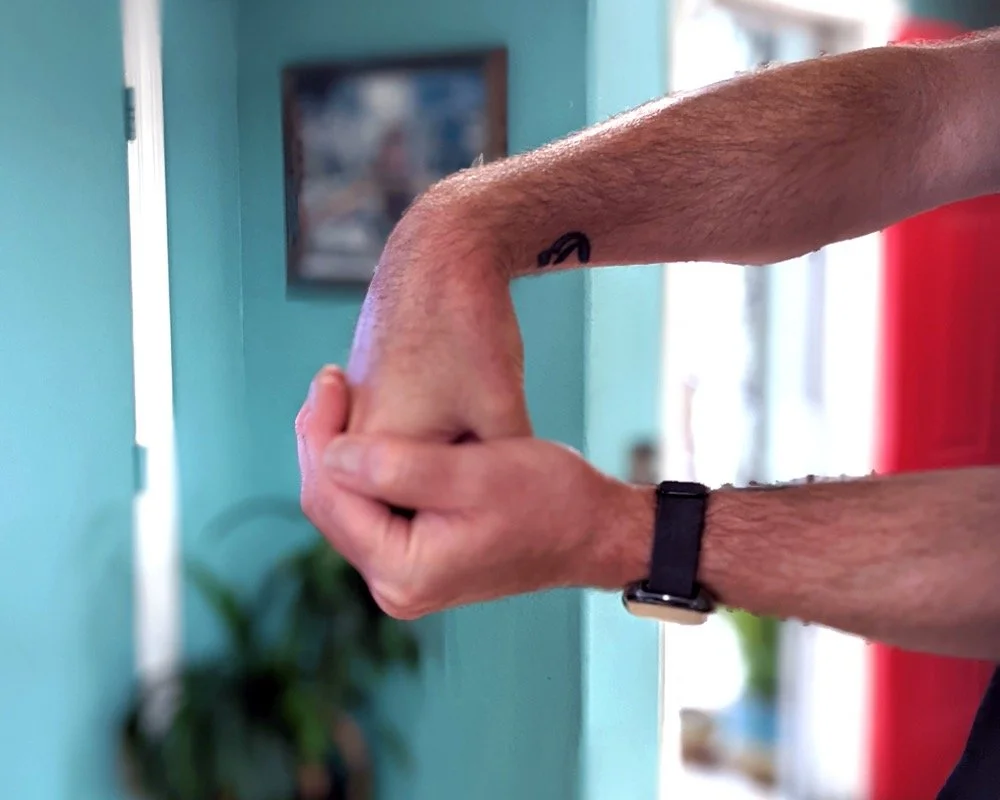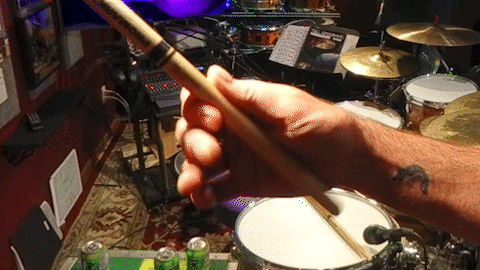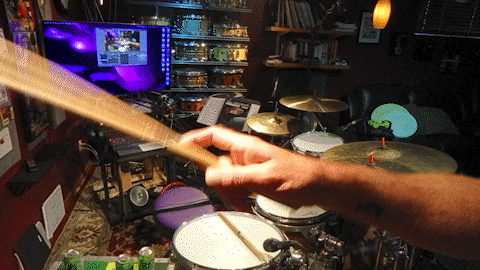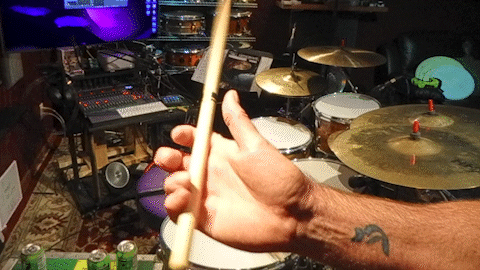I have been playing drums my entire life, since I was able to hold a
pair of drumsticks on my own. My father was a drummer who owned a set
of Ludwigs, which I later inherited and eventually passed down to my
son. The kit was the “Joe Morello model”, which was originally silver
sparkle, but had mellowed into more of a “ginger ale sparkle”,
probably from the gigs he had done in the smoke-filled rooms back in
the 1960s. Sitting in a closet for the better part of 30 years
probably contributed to that color migration as well. The sizes were:
a 13” tom, 16” floor tom, and 22” bass drum which were large for drums
in those days. The date stamp in the shells, where visible, read “Feb.
8, 1961”. The inner ply of the bass drum was maple, while the toms
were mahogany. My son and I refinished it back in 2012, and that’s a
whole ‘other story in itself.
Around the time I was four years old, I saw our very own George
Lawrence (owner/editor of NSMD) play a drum solo at my parents’
photography studio in Jackson, MS during a photoshoot for his band. My
father recorded that solo on one of those old portable cassette
players that resembled a brick with a handle. I can remember listening
to that drum solo over and over; I do remember that it was something
in 6/8, and had a lot of descending wraparound drum fills that later
on, I would discover in the playing of Neil Peart of Rush and
Barriemore Barlow of Jethro Tull.
Eventually the tape broke, and that was the end of that “drum lesson”.
During that time period, I decided that my calling in life was to play
the drums, and somehow I’ve been doing it ever since. It kinda blows
my mind to think about it, actually!
I do remember George had a Slingerland kit that wrapped around from a
6” tom all the way to an 18” floor tom, and every size in between. I
had only seen more drums than that on TV; I believe it was Willie
Ornelas’ kit from the Sonny & Cher show, which would have made sense,
due to their popularity at the time. To say I had “drum envy” was an
understatement, as all I had was a 4pc kit, dreaming of a day when I
could have my own wraparound kit. Looking back, the fact that I even
had a drumkit at my disposal from such an early age was a privilege
that I’ll forever be grateful for.
It goes without saying that over the past 50 years, I’ve put a lot of
miles on my hands.
So one day in about 2016, I was in the attic of my house, swinging
from truss supports and trying to avoid putting a foot through the
ceiling. It was at that time I noticed a nagging pain deep in the
middle of my hand, where my thumb “plugs in” to the largesse of my
palm. It was pronounced, and I could “repeat it”… so I knew something
was not quite right. Overall, my drumming wasn’t affected by it, so I
didn’t pay any mind to it other than the old humorous trope: “if it
hurts when you do *that*, then don’t do *that*…” and so I soldiered on
with gigs and lessons. Not too long after that, ouch…
The Big Ouch
Fast-forward about nine months, and I had begun to feel a bit of pain
in my right hand grip. Side note: I’m a traditional grip player most
of the time, and hadn’t yet begun to experience any symptoms in the
left hand. Those would begin to show up about a year later.
I went to a sports medicine specialist, got X-Rayed and he pulls up
the picture, circles a spot in the middle of my hand and says “yep,
here’s your problem, you’ve got Osteoarthritis. See how the cartilage
is disappearing? And oh yeah, you’ve got a bone spur right here (adds
another circle). Happy day, Mr. Ray!”
Not really great news by any stretch of the imagination, but it’s
information… and knowing what’s up is far better than continuing to
ignore the problem, and wonder why I’m experiencing pain. So I began
to educate myself on how to manage it, because it’s not going to go
away and will continue to degrade as time progresses. I guess we
drummers really do have a “shelf life” of sorts.
Preventative Measures
Over the course of my “journey” with this condition, I’ve gone to a
hand specialist and taken steroid injections several times now.
They’re not too bad… I had incorrectly fantasized they’d be jabbing a
sewer-pipe sized needle into my hand and pumping it up full of goo
with the consistency of axle grease, but it’s actually a very small
needle and the cortisone is of a thin viscosity. Other than the
initial “stick”, the topping off of your “joint capsule” with the
lovely, lovely cortisone is a very bizarre feeling!
Aside from temporary relief and feeling like Superman for the rest of
the day (steroids tend to give me a euphoric feeling), I don’t find
them beneficial for me at this point. They’re certainly not a cure;
rather they’re more of a Band-Aid. My doctor told me their
effectiveness will begin to wear off over time, so I’ve decided to
forego that course of treatment until I get to the point that “nothing
else works”.
The hand doc did craft for me a couple of custom-fit hand braces made
from “Aquaplast”, a polymer material that, when placed in water of a
certain temperature, renders it into somewhat of a fabric that is
easily molded and fitted to any shape you can imagine. These braces do
provide a bit of relief after a long day of hitting things with
sticks, as they tend to immobilize my thumbs and “give them a break”.
It’s just that I always forget to wear them… and so I suffer. :/
Halitosis…I Mean… Holistic Measures
At this point, I’ve found the most effective solution for me to be
holistic in nature. Stretching and warming up on a pad before playing
makes a big difference in my overall performance, and helps cut down
post-performance discomfort. You should always come from the place of
"asking" your body to perform a task rather than "telling" it to.
The stretches I use are three basic moves. I begin with making a
“Stop” gesture, with my arm extended and palm facing forward. Pull
gently with the opposite hand.
Stop/Stretch
Stop-Stretch-fingers
Next, maintain the "stop" pose and turn your fingertips towards the
floor, and stretch that way.
inverted-stop-stretch
And then stretch the individual fingers, one by one.
inverted-stop-fingers
Next, make a fist, curl your wrist under and give a gentle pull.
closed-fist-stretch
Dr. Demento Called...
To preface this paragraph, I’m not a doctor (nor do I play one on TV),
so check with a medical professional regarding any personal
limitations you may have regarding the aforementioned drugs. As for
pharmaceutical options, NSAIDs such as Tylenol (Acetaminophen), Aleve
(Naproxen), and Motrin (Ibuprofen) have proven to work best for me.
I’ll take a couple of Tylenols an hour before downbeat, and it makes
the gig go so much smoother. Post-gig, I’ll have 800mg of Ibuprofen to
help reduce any swelling.
Getting A Grip On Things
During the time I began to feel some level of pain in both hands, it
caused me to examine my grip in an effort to figure out how could I
best reduce the pinching of my thumb and forefinger as the “rotational
axis” for my stick.
billraydrums_Index_Finger_Fulcrum
My solution involved moving the rotational axis to the first joint of
my middle finger, which allows my pinky and ring fingers to also curl
around the stick more easily. The middle finger also comes into play
and provides a much longer and stable “fast fulcrum”, which gives more
power to the stick. It also reduces the amount of pressure my thumb
has to endure in its role providing support to the other fingers in
controlling the stick.
Middle Finger Fulcrum
Because of the increased contact from my fingers, I can completely
remove my thumb from the stick at times, as holding the stick in such
a manner creates a “pocket” for the drumstick to move within. However,
this technique is a bit limiting, as I cannot play buzz strokes, or
anything requiring a prolonged pinch with the thumb & whichever
rotational axis is being used at any given moment (the index finger or
the 1st joint of the middle finger). It’s how I can give my thumb a
rest in between the times I need to utilize it to play a figure that’s
necessary to “mark the musical trail”.
A couple of beneficial byproducts of this somewhat modified “Tony
Williams grip” are the following: 1– My hands are much more relaxed,
and 2– Because of the increased skin-to-stick contact ratio, the
sticks do not have a propensity to slip out of my hands.
open hand
Dealing With Loss
There are things that I used to be able to play that elude me now. I
don’t know if it’s from lack of practicing those particular
techniques, or because my hands don’t take well to the stresses that
some particular rudiments can bring to them. Or subconsciously, I
avoid those things that cause me to notice my creaks and squeaks. I
love to play brushes, and my left hand traditional grip typically
gives me a nudge that I should back off a bit, as the brush applies
sort of an upward pressure to my left thumb joint and puts stress on
it. It’s not that I can’t play brushes, I just had to modify my
technique a bit to do so and have to “mentally prepare” to be able to
back off a bit if & when my thumb starts screaming out our “safe word”
(it’s “Eyjafjallajökull”, in case you’re interested…)
At any rate, when I was in my 20s, I once heard someone in a
discussion say about guitar great Jimmie Vaughn “He (JV) has forgotten
more chops than anyone else will ever play”, or something to that
effect. That’s a bit of a stretch, LOL… but it sounded cool to me, and
it fit in with the #1 thing I was hearing at that time from people who
were employing me in their band. To quote a legendary drummer from San
Diego named Ray Tejedas, aka “The Counselor”, “You gotta lay dead,
kid”. Lay. Dead.
So I took that line to heart over time (read: almost 30 years!), and
began to let go of things I “hear” that don’t necessarily serve the
music well. As they say, “you gotta choose your battles wisely” and so
I began to take on the attitude to “leave the pyrotechnics to the
young cats”. Steve Ferrone once gave me some great advice: “When you
hear a fill in your head, don’t play it, wait ‘til it comes around the
next time then do it.”
All of this is ironic, as my current gig is with a guitarist who is
both exalted as legend, and known as one of the fastest guitarists in
the world. I’ve come to realize I wasn’t hired for my ability to “play
fast”. I’m there to make good musical choices, and craft for the band
rhythmic equations and statements congruent with what’s being played
in the moment.
What Lies Ahead
Arthritis has been somewhat of a blessing in disguise; ergo: this is
me, remaining optimistic and positive that I’ve still got a lot of
years in this business of drumming, and I’m going to soldier forth and
keep on doing this until the day I cannot. It’s caused me to make
better musical choices overall when playing with others.
I really haven’t “lost” anything so far, since my discovery. Rather,
I’ve learned to adapt to the new “features” my body is revealing to
me, and the workarounds haven’t been all bad.
And as a note to my four-year-old self… Hey kid, You’d rather play a
4pc kit anyway. It’s less confusing and easier to set up/tear down. :D









